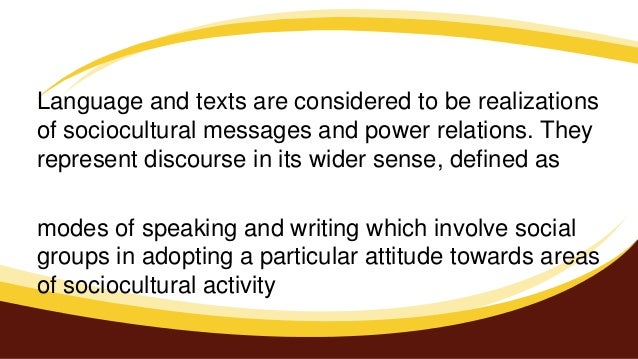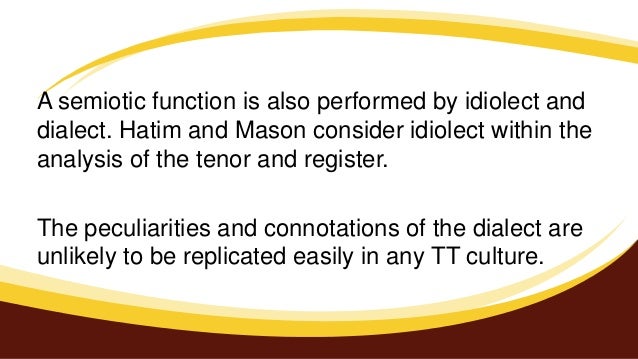Discourse And The Translator Hatim Pdf Download
Hatim Basil & Mason Ian. Discourse and the translator. Language in Social Life Series.Longman, 1990, 258 pages. Honey bee malayalam movie review. Discourse and the Translator is a book for people interested in the linguistic aspects of translation, mainly the possibilities that Discourse Analysis can bring to.

. Part of the book series (PADLL) Abstract The concept of ‘discourse’ (whether simply in the sense of the organisation of verbal interaction or as uses of language giving voice to the meanings and values of social institutions) has been current in translation studies for many years without generating a great deal of debate about how discourses actually affect translator behaviour.
Ian Mason
- PDF DISCOURSE AND TRANSLATOR BY HATIM AND MASON. Hatim B Mason - Discourse and the Translator - Ebook download as PDF File (.pdf), Text File (.txt) or read book online. Discourse and the Translator B Hatim, Ian Mason. Conventions cultural deixis dental caries DGSE dialect discourse dynamic equivalence effect elements English Enoch.
- Participated (tenor), and what medium has been selected for relaying the message (mode). Together, the three variables set up a communicative transaction in the sense that they provide the basic conditions for communication to take place. Source: Hatim, Basil and Ian Mason. Discourse and the Translator.

Starting from Foucault’s notion of discours, and drawing on (critical) discourse theory (Blommaert 2005) and Hatim’s (e.g. 2001) notion of socio-textual practices, this chapter places discourses and translators within the framework of communities of practice (Wenger 1998). Viewing translation as a socially situated activity implies consideration of the multiple communities of which translators (and other text users) are members — and the essential role of discourses in negotiating, reinforcing or challenging power relations (Barton and Tusting 2005). This, in turn, argues for an inclusive account of the act of translating, relating all participants to the processes of positioning of self and others, negotiation and ownership of meanings, in which they are involved. Issues of identity and power are thus central to this conception of translating, not in the sense of predetermined positions or roles but as negotiated social practice.
From this perspective, a particular case of translating is then examined in an attempt to relate overarching theories to actual translation processes and to draw together discourse theory, elements of a sociology of translation and the decisions translators make at both micro-level (for example, word choice) and macro-level (for example, textual strategy).
Hatim and Mason Translation Theory and Practice (Compressed Discussion). 1. Hatim and Mason: The Semiotic Level of Context and Discourse Reported by Bea Patrizia Santos. Semiotic Level, Context, & Discourse Signs and sign processes The circumstances that form the setting for an event, statement, or idea, and in terms of which it can be fully understood and assessed Conversation. Two other works that develop out of the Hallidayan model of language were especially influential for translation studies in the 1990s: Basil Hatim and Ian Mason’s Discourse and the Translator (1990) and The Translator as Communicator (1997). Basil Hatim & Ian Mason.
Analysis of functions Changes in the transitivity structure in the English translation are seen to cause a shift in the ideational function of the text. Material process intention action process event process real action process. Modality Classification of logical propositions according to their asserting or denying the possibility, impossibility, contingency, or necessity of their content. Hatim and Mason’s ‘foundations of a model for analysing texts’ incorporate and go beyond House’s register analysis and Baker’s pragmatic analysis. They combine the bottom-up analysis discussed in the Camus example with some top-down consideration of the semiotic level of the text.
Language and texts are considered to be realizations of sociocultural messages and power relations. They represent discourse in its wider sense, defined as modes of speaking and writing which involve social groups in adopting a particular attitude towards areas of sociocultural activity. A semiotic function is also performed by idiolect and dialect.
Heriot Watt University
Hatim and Mason consider idiolect within the analysis of the tenor and register. The peculiarities and connotations of the dialect are unlikely to be replicated easily in any TT culture. Although Hatim and Mason propose ‘foundations’ for a model of analysing texts, they deal with a large number of concepts. It is not clear that their approach constitutes a model that can be ‘applied’ in the conventional sense of the term.